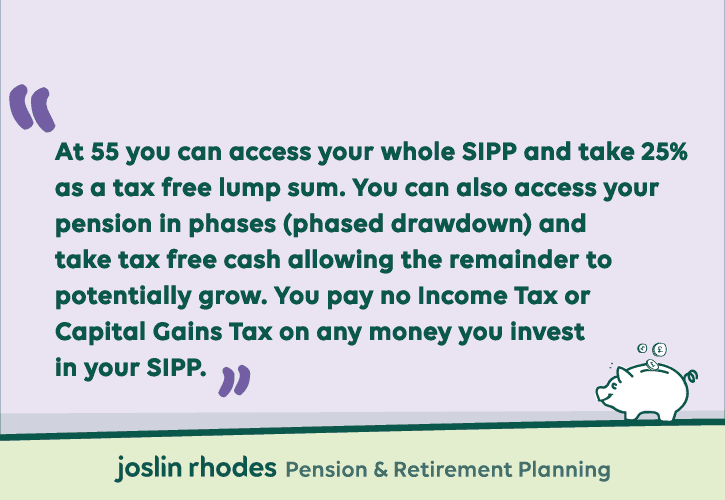Related Articles
Do you pay tax on a SIPP?
A self-invested personal pension (SIPP) is a type of personal pension that allows you to build up a retirement pot through savings and investments. Because SIPPs offer a wide range of investment opportunities and tax benefits, you will need to know the tax rules for your individual circumstance to know if you need to pay tax on a SIPP.
At 55 you can access your whole SIPP and take 25% tax free lump sum. You can also access your pension in phases (phased drawdown) and take tax free cash allowing the remainder to potentially grow. You pay no Income Tax or Capital Gains Tax on any money you invest in your SIPP.
Basic rate tax payers who invest in a SIPP will receive a 20% top-up with higher and additional rate payers able to claim back a further 20% or 25%. The regulations governing SIPPs are clear but the decisions you make about your life and retirement will have a big impact on how much tax you pay, read on to find out more.
How Does SIPP Tax Relief Work?
Tax relief on your SIPP essentially means the government is returning a portion of your income tax as a pension credit on your pension contributions.
You can contribute up to 100% of your earnings to your SIPP (up to the current Annual Allowance of £40,000 gross) and receive 20% pension tax relief on contributions up to that amount. Tax relief rates on your SIPP in England, Wales and Northern Ireland are different to the rates in Scotland:
Income Tax Relief Rates on your SIPP For England, Wales, and Northern Ireland:
- 20% Basic Rate
- 40% Higher Rate (Over £50,000 pa)
- 45% Additional Rate (Over £145,000 pa)
Income Tax Relief Rates on your SIPP For Scotland:
- 20% Basic Rate
- 21% Intermediate Rate
- 41% Higher Rate
- 46% Additional Rate
How is the tax relief calculated for SIPPs?
SIPP Tax relief is a government incentive for you to save towards retirement. The government pays at least 20% of the total amount you invest in your SIPP.
For example, If you invested £1,000 into your SIPP, the government will top it up to £1,250.
| Amount Invested (net) | Government Top-Up (20%) | Total In Your SIPP (gross) | Additional Tax relief for Higher Rate Tax Payers | Effective Cost For Higher Rate Tax Payers |
|---|---|---|---|---|
| £1,000 | £250 | £1,250 | £1,250 | £750 |
| £3,600 | £900 | £4,500 | £9,000 | £2,700 |
| £7,500 | £1,875 | £9,375 | £1,875 | £5,623 |
| £15,000 | £3,750 | £18,750 | £3,750 | £11,250 |
| £30,000 | £7,500 | £37,500 | £7,500 | £22,500 |
When is tax relief added to a SIPP?
Different SIPP providers will have their own ways of working. The cut-off points for claiming tax back will be different for each one.
Usually, you make your SIPP contribution every month. Then your SIPP provider will reclaim the basic rate of tax back from HMRC and pay it into your account the following month. If you pay a higher rate than the basic rate you may have to claim back the excess yourself via tax self-assessment.
How much can you contribute to your SIPP?
You can contribute as much as you like into a SIPP. However, the amount that is eligible to benefit from tax relief is limited to the lower of your relevant earnings (i.e. salary) or £40,000 per tax year (the annual allowance).
What is the lifetime allowance 2021-22?
The lifetime allowance is the maximum amount you put into your SIPP and all other pension pots, combined, over your lifetime before being subject to a tax charge.
The amount you’re allowed to receive tax relief on changes each year but has currently been frozen. In 2021/2022 the lifetime allowance is £1,073,100 and in previous years it was:
| Tax Year | Lifetime Allowance | Annual Allowance |
|---|---|---|
| 2021 – 2022 | £1,073,100 | £40,000 |
| 2020 – 2021 | £1,073,100 | £40,000 |
| 2019-2020 | £1,055,000 | £40,000 |
| 2018-2019 | £1,030,000 | £40,000 |
| 2017-2018 | £1,00,000 | £40,000 |
| 2016-2017 | £1,00,000 | £40,000 |
If you go over the lifetime allowance the excess is taxed at 25% (plus Income Tax) if you take the excess as income or 55% if you take the excess as a lump sum.
What is the annual allowance 2021-22?
The annual allowance is the maximum amount of money you can put into your SIPP retirement plan each year that benefits from pension tax relief. In 2021-22 it’s £40,000.
What is the tapered annual allowance?
The tapered annual allowance reduces the amount you may contribute to your pension each year while still receiving tax benefits. Anyone having a threshold income of more than £200,000 or an adjusted income of more than £240,000 for the tax year may be eligible for the tapered annual allowance.
The table below shows how the tapered annual allowance works based on the standard annual allowance of £40,000 for this tax year, 2021-22.
| Annual Income | Annual Contribution Allowance |
|---|---|
| Up to £240,000 | £40,000 |
| £250,000 | £35,000 |
| £260,000 | £30,000 |
| £270,000 | £25,000 |
| £280,000 | £20,000 |
| £290,000 | £15,000 |
| £300,000 | £10,000 |
| £310,000 | £5,000 |
| £312,000 | £4,000 |
How does the Money Purchase Annual Allowance Work?
The Money Purchase Annual Allowance is triggered if you draw taxable income from your pension (MPAA). This means that instead of the normal £40,000, you will only be able to save £4,000 each year tax-free. Additionally, you will no longer be able to ‘carry forward’ unused allowances from the previous three tax years.
Can I carry forward any unused tax relief from a SIPP?
If you hit the following criteria, you may be eligible to carry forward your unused annual allowance from any of the previous three years:
- You’ve used up your annual allowance for this tax year.
- You’ve been a member of a pension scheme in each tax year you want to carry forward from.
- Your employer and personal contributions are less than £40,000 in one or more of the previous years.
- You’ve earned at least the amount you’re contributing that tax year.
How does SIPP withdrawal work?
SIPPs form part of a flexible retirement income. It is not normally possible to withdraw money from a SIPP before the age of 55 (57 from 2028). When you decide to start taking money from a SIPP tax is charged at your marginal rate (SIPP withdrawal tax) depending on your income from that tax year.
SIPP withdrawal taxation is done at source by the SIPP administrator. In some cases, they have a flat taxation depending on the value withdrawn, so you may have to contact the HMRC to reclaim any overpaid tax.
What are the SIPP’s tax benefits?
SIPPs can be very tax efficient if used correctly:
- The Government will match your savings in your SIPP pension pots with pension relief.
- You can keep paying into a SIPP until the age of 75.
- You’re guaranteed a 20% tax bonus on your savings. higher and additional rate taxpayers could get a further 20% or 25% tax relief on SIPP contributions.
- A 25% lump sum of your SIPP pension fund can be withdrawn from your pension pot tax free
 Can I withdraw my SIPP as a lump sum in one go?
Can I withdraw my SIPP as a lump sum in one go?
You can, but it’s very unlikely that it’s the best decision. When you take money out, your withdrawals are taxable income paid at your marginal rate.
The table below shows the tax impact of taking a SIPP as a lump sum assuming you receive the maximum basic state pension £175.20 per week in 2021/2022and have a SIPP fund of £250,000.
TABLE
Can I withdraw my SIPP over 5 years?
You can withdraw your SIPP over any timescale you wish or need but there may be tax consequences of taking large sums in a single tax-year.
The table below assumes you receive the maximum basic state pension £175.20 per week. And have a SIPP fund of £250,000 that you take over 5 years.
| Income | Total Income | ||
|---|---|---|---|
| State Pension | £9,110 | ||
| Pension Withdrawal | £50,000 | £59,110 | |
| Band | Income Tax | Total Tax | |
| Pension tax-free Cash | £12,500 | 0 | |
| Pension Allowance | £12,570 | 0 | |
| Income Taxed at 20% | £34,040 | £6,808 | |
| Income Tax Over 5 Years* | £34,040 |
Total amount received from the pension over 5 years is £215,960. Income Tax represents 13.6% of the Pension Fund, Assuming the personal allowance and basic-rate tax charge remain unchanged
Can I withdraw my SIPP over 10 years?
You can withdraw your SIPP over any timescale you wish or need but there may be tax consequences of taking large sums in a single tax-year. The table below assumes you receive the maximum basic state pension £175.20 per week. And have a SIPP fund of £250,000 that you take over 10 years.
| Income | Total Income | ||
|---|---|---|---|
| State Pension | £9,110 | ||
| Pension Withdrawal | £25,000 | £34,110 | |
| Band | Income Tax | Total Tax | |
| Pension tax-free Cash | £6,500 | 0 | |
| Pension Allowance | £1,00,000 | 0 | |
| Income Taxed at 20% | £15,290 | £3,058 | |
| Income Tax Over 10 Years* | £30,580 |
Total amount received from the pension over 10 years is £219,420. Income Tax represents 12.2% of the Pension Fund, Assuming the personal allowance and basic-rate tax charge remain unchanged
From the examples above you can see how much tax you’d pay if you took your whole SIPP as a lump sum, £73,435 compared to only £30,580 if you took the same amount over 10 years. It’s well worth seeking independent financial advice to find out what’s best to do based on individual circumstances.
Are SIPPS Subject to Inheritance Tax?
Your beneficiaries won’t pay inheritance tax on your SIPP unless you have taken the 25% tax-free lump sum (The lump sum would be liable to inheritance tax).
As long as your SIPP remains untouched your beneficiaries won’t pay inheritance tax. If they choose to take the benefit as a lump sum, but do not claim it within the two-year period (after you pass away), then they will pay income tax on the benefit.
Are SIPPs subject to capital gains tax?
Deposits into SIPPs as well as any gains are not subject to capital gains tax.
Do you have to declare a SIPP on your tax return?
If you want to claim back tax on your SIPP contributions at a higher or additional rate then you will have to declare by filling out a self-assessment tax return. For the basic rate it’s usually paid at source, but you should check to be sure.
Is it better to have more than one SIPP?
The short answer is yes, it is better because you can open more than one SIPP, and indeed many investors choose to hold multiple accounts. You can also open one or more SIPP accounts alongside other investment products you may have, such as workplace pensions or ISAs.
Regardless of how many accounts you hold, you will need to make sure that you don’t exceed either your lifetime allowance (currently £1,073,100) or annual allowance (£40,000) across all investments, or you will incur overpayment tax charges.
Can two people pay into one SIPP?
It’s not possible to have a joint SIPP between two people, but someone else (for example your partner) can pay into your pension. You’ll automatically get basic rate tax relief at 20% if your pension provider claims it for you (relief at source).
If you’re in a workplace pension that allows other people to contribute, the tax rules and tax treatment may differ. You may need to speak to HMRC to receive tax relief. If in doubt it’s always worth seeking independent financial advice.
How can I withdraw funds from my SIPP in the most tax-efficient way?
There’s no one size fits all solution to withdrawing a SIPP pension. It’s best to seek independent financial advice so that you can be advised on the best route for your particular circumstances and in the most tax efficient way.
Fixed-term annuity
You get a guaranteed income for the agreed term which is usually five to ten years. At the end of the term you’ll usually get a lump sum (‘maturity amount’). The lump sum is any money you’ve paid in, how much it’s grown, minus the money you’ve received.
This means you’re not tied into one provider for the rest of your life and gives you the flexibility to get a better rate based on your changing circumstances.
Lifetime annuity
A lifetime annuity is usually bought with money from your pension pot and will pay you a guaranteed income for life. That’s peace of mind that you won’t run out of money regardless of how long you live and, you can buy an annuity that increases each year so you’re protected from things like inflation.
When you buy a lifetime annuity, the decision is irreversible and you might get less than you paid for your annuity depending on how long you live. You can provide an income or lump sum for a dependent when you pass away.
Purchased life annuity
You can buy a purchased life annuity with money that’s not in your pension pot. Some people choose to buy one with their 25% tax-free lump sum.
It works the same way as other annuities but is treated differently when it comes to tax. You don’t pay tax on the money you put in (the capital) but you do pay income tax on the interest it makes.
Enhanced annuity
Enhanced annuity is also known as an ‘impaired life’ annuity. Enhanced annuities offer higher guaranteed income based on health problems or if you’ve been diagnosed with an illness. Certain insurers will also offer you higher rates depending on what you’ve done for work or where you live in the country.
You will get questions about your health and the insurer will likely ask your doctor for more information. They’ll probably want you to attend a medical examination because the rate you offer is based on your life expectancy.
Some of the health problems that mean you could get a higher guaranteed income include:
- Stroke
- Cancer
- Diabetes
- Heart attack
- Kidney failure
- Chronic asthma
- Multiple sclerosis
- High blood pressure
- High cholesterol
Don’t take our word for it…
Meet some of our clients and see what they think of us,
the PlanHappy process and how it’s helped them do what they wanted…
About The Author
We're trusted to manage over £190 million of our clients funds We're authorised and regulated by the Financial Conduct Authority The unique PlanHappy Lifestyle Financial Planning process has been specifically designed to help you get what you wantWhy choose Joslin Rhodes?
Over £190 million
FCA Regulated
Proven Process
"I cannot find fault with the service we received. From the warm yet professional welcome to the financial advice we were given. You as a company should be proud of the service you are providing" Mr. WTalk To The Experts
Ready to talk? Our friendly team are here to help. Simply pop a few details into the form and we'll be in touch.
We'll show you:
When you can afford to retire
How much money you'll need in retirement
How to make the most of your pensions and other assets to fund your lifestyle
4.9 out of 5 stars on VouchedFor






